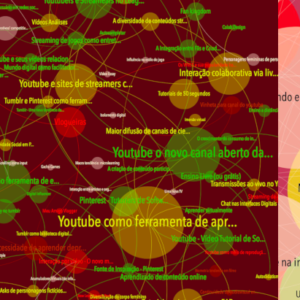Graphs are mathematical structures that relate a sequence of entities that share an abstract connection between them. The connections are expressed through edges (links) that connect the related entities (nodes). Graphs are mostly used to find similar entities of different kinds through common linking patterns. Graph visualization is a common technique employed by social network analysis. However, graphs can be used for the opposite motive: finding differences in apparently similar entities. Differentialist Graphs are those that heighten qualitative differences in node properties and link patterns through graphic design features.

This method has been developed and applied in the Digital Trends Observatory. The Differentialist Graphs found conservative linking patterns in digital trends that were not visible otherwise.
The study builds upon the social change theory proposed by Henri Lefebvre in his Manifiesto Diferencialista. In differentialism, broad social change occurs through the conflict between homogenizing forces – which benefit from maintaining the status quo – and differentiating capacities – which grow with the decay of the status quo and the inability of normality to satisfy everyday desires. When homogenizing forces predominate over differentiating capacities, the production of differences is reduced to a minimum, that is, it is reduced to the accumulation of small variations in pattern repetition. The products and services generated by these trends tend to be marketed quickly due to the commodity equalization process. The trends produced by the homogenizing force are usually conservative, as they aim at rapid circulation and decay. When differentiating capacities predominate, the production of differences is maximum. There are then qualitative leaps, radical innovations, unexpected changes, and the creation of works that mark epochs.
Differentialist Graphs tries to identify and visualize such differences in networked societal process, such as the social production of design space. This method can be used in combination with controversial design space mapping.
References
Van Amstel, Frederivan Amstel, F. M. C. (2021). Conservatism in Digital Trends: Findings from a differentialist analysis of influence graphs. InfoDesign – Revista Brasileira De Design Da Informação, 18(2), 37-52. https://doi.org/10.51358/id.v18i2.933

